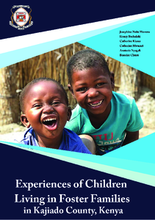Foster care is perceived as a viable alternative in the care for and protection of vulnerable children particularly for those whose family situation is deemed as dysfunctional as to present reasonable risk to their wellbeing. In the context of a governmental policy Kenya that seeks to redirect foster care practices towards more use of family-based foster care, this study was undertaken to seek a proximate appreciation of the experiences of children whose lives now oscillate between two alternative care environments, namely, foster family settings and Charitable Children Institutions (CCIs).
Kenya has a huge number of children that grow up in need of alternative care, with an estimated 3.6 million of these being orphaned or classified as vulnerable (UNICEF, 2015). The alternative care structures, while embedded in a rich national and international legal framework, are not adequately implemented. Even basic registration of CCIs has significant gaps (UNICEF, 2014).
Research from global to local sources shows the huge disadvantages for children growing up in institutions other than families and give ample rationale for the move of the Kenya Government to de-institutionalize as many children as possible by bringing them into family-based care.
The study adopted the phenomenological research design, purposive sampling 26 preteens and teenagers living, during the school term, in a CCI that doubles up as their School and then moving to live with foster families during the school holidays. The latter was a recently introduced new move that enabled the CCI to comply with new government directives.
Interview schedules were used to collect data which was then analysed using an inductive thematic approach. The focal area of the field study were the experience in the CCI, the transition to the foster families and the experience in the latter for each of the interviewees.
Among important findings of the study includes an overall happy environment for the children in the CCI, including a good variety in diet, and adequate sense of safety among other key basic needs. The children present with a sense of security in the home as their regular and predictable programme as well as well elaborated system of values this CCI makes them feel clear of their way. Above all the children are confident of a great education that they receive in the home, and this makes them very hopeful and even resilient.
Transition to the foster family homes seems to be overall rather poorly managed due perhaps to the lack of preparation of the staff for the role of assisting the children to prepare for the transition. In particular, the children did not experience a sense of choice in the transition matter. It was a decision communicated to them. This may not have facilitated ease of transition, and indeed the some of the reports of the children indicate some anxiety in the transition period. But in most cases the children had positive experiences in the foster homes anyway. It may be observed that the fact that most of the foster families were in relationship to the school as a faith affiliate may have helped the children to make an easy transition to the family homes despite lack of adequate preparation. Concerning the experience of reception in the foster family majority of the children felt welcome, appreciated and accepted.
The findings of this study provide information that will be used to improve foster care in Kenya. In particular, there is much to be learned from the positive experiences accrued by the children while in the CCI. Among these is the security provided by a strong institutional tradition and system of values. If in addition, the foster families to which the children are sent share the same values, this can be an advantage for the consistency of their upbringing and their psychological security.
The study also shows the dire need for ongoing training of care-givers throughout the spectrum of foster care. Many of the successful experiences of the study point to the importance of establishing traditions as those of the school, as well as predictable systems. The gaps in the foster care system that this study unearthed are also clearly gaps in the accompaniment processes, both in the CCI and in the foster families.
Life-skills training also needs to be increased for children in foster care. This can help them build up resilience in the changing seasons of their lives and enable them to draw more value from them. Their psychological experience and preparedness needs to be taken on board in the decisions that affect them.
In all the study serves to confirm the adroitness of the policy direction taken by the Government of Kenya regarding family-based foster care; it is a useful supplement to CCI care when the latter is necessary.

